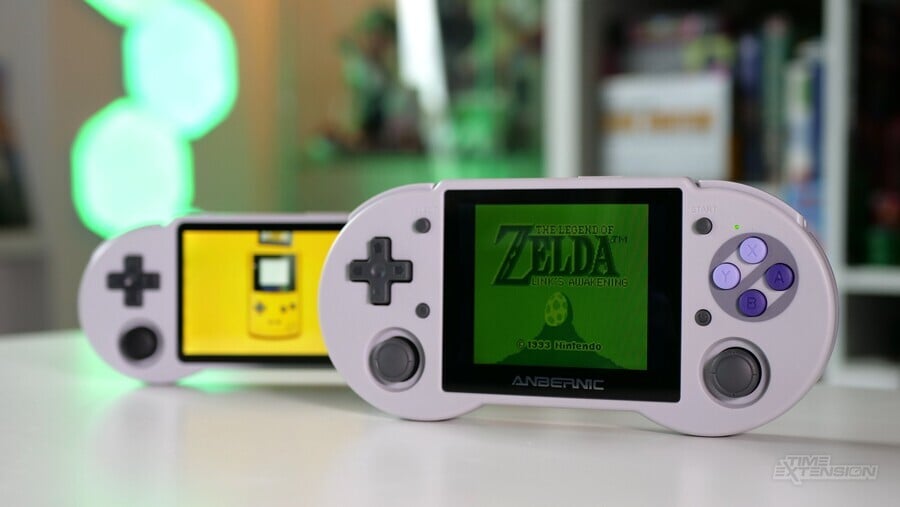Hands On: Anbernic RG353P – Shamelessly Inspired By Nintendo

Nintendo’s influence on the world of gaming surely needs little explanation; while the Japanese company didn’t ‘invent’ video games, it has done more than most to establish many of the ground rules for the medium. It’s little wonder, then, that so many companies look to Nintendo when it comes to creating their own gaming endeavours, and nowhere is that more true than in the realm of Chinese-made emulation devices.
We’ve already seen the likes of 8BitDo ‘adapt’ the iconic NES and SNES controllers for their range of Bluetooth controllers, and the PocketGo S30 (which was co-designed by a member of 8BitDo) is essentially a SNES pad with a screen and emulation powers. Now, Anbernic – arguably one of the leading forces in this field – is back with another retro-focused portable, and it basically looks like a beef-up version of the PocketGo S30. Say hello to the RG353P.
Anbernic, of course, is most famous for its iconic RG351, which is considered by many to be one of the best devices of this type. The company has been cranking out similar products since then – including the RG351V, RG503, RG300X and RG552 – but there’s been a feeling of slight discontent amongst fans who are still patiently waiting for the ‘true’ successor to the RG351. As much as it pains us to say it, the RG353P probably isn’t that machine – but that’s not to say that it isn’t worth a look if you’re in the market for one of these portables.
The biggest news is, of course, that SNES-style design. The RG353P is larger and heavier than the PocketGo S30, but feels like a close match in terms of pure build quality – and that’s a good thing, as the PocketGo S30 boasted premium construction and materials for such a low-cost device.
The RG353P’s D-Pad is nice and responsive, as are the four main face buttons. There are four shoulder buttons (which are also good), as well as four other function buttons on the front: Start, Select, Function and Power. These are arranged around the 3.5-inch IPS screen but are thankfully small enough that you won’t accidentally hit them during play. Rounding things off are two analogue sticks, which look and feel very much the same as those on the Nintendo Switch (that might not be a good thing, of course).
The stereo speakers are nice a powerful and are located on the bottom edge of the device, in a location where you’re unlikely to smother them with your palms. Also located on the bottom edge are the twin MicroSD card slots and the 3.5mm headphone jack. Interestingly, there are two rubber pads on the rear of the RG353P, which means you can rest the device on a table without it sliding around. These initially look quite odd, but are very welcome – we’d like to see this on more portable consoles, if we’re honest.
While the RG503 boasted a gorgeous OLED screen, the RG353P has an IPS LCD panel, which means it doesn’t pop quite as much. It’s still a decent display, however, and the 640 x 480 resolution is perfect for retro gaming. It has touch support, too, which is neat; this is down to the fact that the RG353P has a dual-boot feature, which means you can either use the Linux interface or plump for the full-fat Android 11 one. Android needs touch control to really work, hence the inclusion here.
Like the RG502, the RG353P is powered by the new RK3566 quad-core chipset, clocked at 1.8GHz. There’s 2GB of RAM, too, which means that performance is noticeably improved over the RG351 family of systems. You’re still not going to get 100% full-speed on the entire N64 and Dreamcast library, but the vast majority of games for those consoles will run fine – and anything prior to those formats is silky-smooth (with the exception of the Sega Saturn, which is notoriously tricky to emulation on low-cost hardware). If you’re looking for something that really nails the 8 and 16-bit eras, then you’ll have little to complain about here.
Factor in 5G Wifi, Bluetooth 4.2, HDMI-out, two USB-C ports and a 3500mAh battery that’s good for around 4-6 hours of gameplay, and you’re getting a lot of bang for the $140 the RG353P costs to purchase. Does all of this add up to a machine that can really be considered to be the RG351’s successor? Unless you’re super keen on the idea of having the ability to boot into Android, then perhaps not, but there’s no denying that the RG353P is an excellent entry point into the world of portable emulation – and the fact that Anbernic has been brazen enough to copy Nintendo’s design means it looks great and is comfortable to use, as well.
Please note that some external links on this page are affiliate links, which means if you click them and make a purchase we may receive a small percentage of the sale. Please read our FTC Disclosure for more information.
Thanks to DroiX for supplying the RG353P used in this feature.












